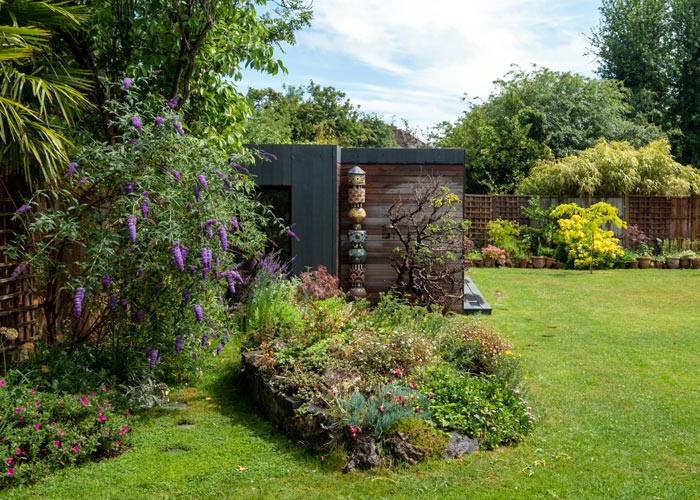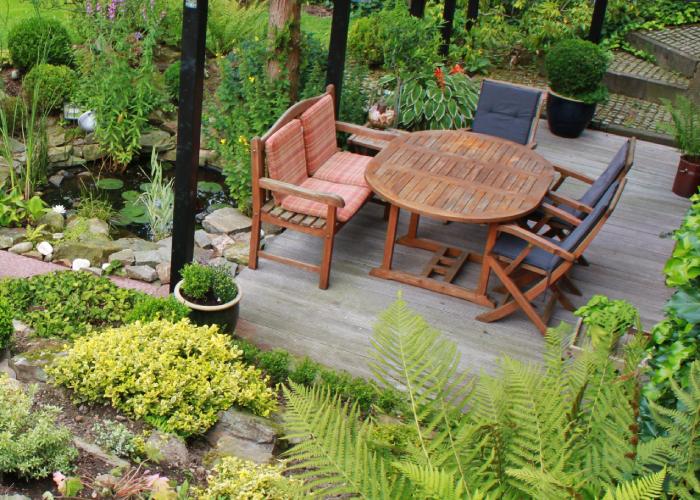Investing in your garden is so much more than a way to boost property value. Gardening is great for mental wellness, and a tranquil outdoor space can also be an additional entertaining or relaxing area. But the idea of keeping up with endless garden chores is quite demotivating for most homeowners.

Fortunately, a tranquil, beautiful-looking garden doesn’t need to be hard work. What’s more, low-maintenance landscaping designs usually have a modern minimalist vibrancy that property buyers find appealing. As a result, low-care gardens can boost property value even more.
With these low maintenance garden ideas, you can cultivate a value-adding garden that needs minimal care.
Choose The Right Lawn
There are dozens of different species of grass. Each type of lawn looks different and requires varying care while thriving best in specific conditions. So the best approach to choosing a suitable lawn type is to research the ideal species of grass species for your region and climate.
Once you have chosen a lawn type, it’s essential to learn about care requirements that determine watering and trimming needs. Lawn Care Pro is a great place to learn how to keep your lawn lush and thriving all year round.
Even though many online resources will suggest that artificial lawns and no lawns are the best ways to cut back on garden chores, these options are not at all eco-friendly.
Reduce Lawn Size
The best way to cut back on gardening chores is to minimize the amount of lawn area in your garden. Less lawn directly means less mowing and watering. Without obliterating your lawn, you can make it easier to tend to by minimizing the amount of space it uses up in your garden.
Even though removing all of your lawn is not recommended, you can free up some lawn area to make way for a water feature, deck area, or even a firepit. Otherwise, you can create pathways and add more flowerbeds to minimize lawn size.

Pick The Best Plant For The Right Place
The most practical way to ensure your plants thrive without excessive care is to choose the right plants for your garden’s conditions. For example, lavender grows best in free-draining soil and does not do well in soggy spots. So the best places to plant lavender are sunny spots where the soil is usually dry.
When plants grow in the right conditions, they need less additional care; if the soil is perfectly damp and the plants are exposed to enough rain and sunshine due to the climate, you will only really need to spend time trimming and pruning plants.
Use Large Pot Planters
The smaller a pot is, the more care the plant will need because the soil will dry out quickly. So, bigger pot planters can reduce the amount of care plants need as the soil can stay wet for longer. Using larger pots is also a great way to reduce lawn size without trimming back on nature.
Use Mulch
Mulching refers to using other materials to cover bare soil in between plants. The most common materials used for mulching are gravel, bark chippings, and pebbles. While mulching can be used as a charming design element in your landscaping plan, it will also reduce the amount of care your garden needs.
This technique is often used to prevent weeds from growing while also preventing evaporation to keep the soil damp for longer. As a result, mulching is often seen in commercial landscaping designs as well.

Embrace Some Wild Nature
Extra neat gardens undoubtedly need much more attention than freely growing ones. But because you should avoid creating an overgrowing garden that looks neglected, choosing only a few free-growing plants is best.
English vines, snake plants, lavender, and wildflowers are a few types of magnificent plants that can grow freely without needing much attention when it comes to trimming and pruning. You can also let low-growing plants take over cracks in walkways and let creeper plants grow as they choose.
Raise Your Plant Beds
Raising beds from the ground level will make gardening a lot easier. It’s a lot easier to plant, weed, and water plants that are higher up. You can also use rustic wood slats or modern cement slabs to raise beds while dressing up your landscaping design at the same time.
If you are hoping to create a low-maintenance garden on a budget, you can raise plant beds with cinder blocks or concrete blocks.
Choose Low-Maintenance Patio Furniture
Even though fabric sofas and occasional chairs might be more appealing to some, some patio furnishings require a lot more care than others. So instead of choosing patio furniture purely on preference, it’s wise to pick outdoor furniture that’s durable and low maintenance.
All-weather wicker, teak, metal, and cedar wood are all low-care and durable materials to choose from for outdoor furniture.

Start A Vertical Garden
Installing plant boxes and pots vertically on a garden wall is a great way to make the most of a smaller garden as a space-saving landscaping idea. However, this gardening style can also reduce garden maintenance quite a bit. Because water will trickle down from plants at the top to those at the bottom, vertical gardens are pretty low maintenance.
With this idea, choosing low-maintenance plants that don’t need full sunlight to thrive is also essential in reducing garden care efforts. Aeonium, fern, clematis, peace lily, petunia, and herbs like parsley, basil, and oregano are all suitable plant types for vertical gardens.
Find A Reliable Landscaping Service
Even though there are many smart ways to design your garden to minimize chores, the best way to eliminate garden care from your household chores is to rely on a residential landscaping service. These services are pretty affordable, but it’s still worthwhile to compare services in your area.
Landscaping services can also help you design a low-care garden that needs as little attention as possible, reducing the number of visits you will need from the service annually.
There are tons of beautiful landscaping ideas, whether you’re hoping to create a low-care oasis or a charming outdoor entertainment area that doesn’t need much attention.




